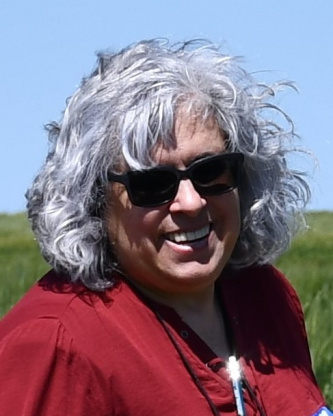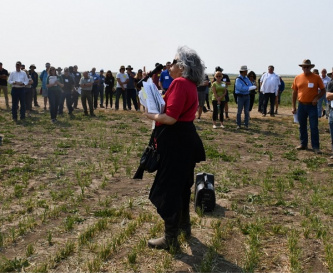Wandering the aisles of your local grocery store, you might not think about the journey of the organic products in the produce section. But when it comes to farming, organic methods of growing still aren't common. Agriculture and Agri-Food Canada (AAFC) researcher Dr. Myriam Fernandez is working to change that and has spent her career helping organics find space in the field. As an organic food lover herself, she’s not afraid to get her hands dirty to get more love for this production system.
An uphill battle

Dr. Myriam Fernandez
At the Swift Current Research and Development Centre (RDC)— in the heart of one of Canada’s conventional, large-scale field cropping areas —Myriam has spent the last 30 years developing new practices to improve the world of agriculture. While she started her career studying plant diseases like Fusarium Head Blight, root rot and leaf spots (common diseases of wheat and other crops), she became increasingly interested in low input (using a reduced amount of synthetic product to help grow crops) and organic farming practices in the late 1990s.
But in the early years of her organic farming research, Myriam received a lot of questions about the relevance of this work: “I could see that, in large part, Prairies farmers were relying on new seed technologies and chemical applications to increase their yields but often weren’t considering alternative practices, like diversified crop rotations, to mitigate disease or insect pressures,” says Myriam. “Because of the potential environmental downsides to conventional practices, which were also being expressed by some farmers and other researchers, I wanted to apply my research skills in this area."
Though Myriam wanted to bring organic research forward, the industry wasn’t quite ready for it. To support her cause, she continued her research, and it wasn’t long before it started to pick up traction.
Increasing support
As time went by and the market opportunity for organic products grew, the Prairie agriculture industry became more comfortable with organic farming.
“We had focused our research on ‘low input’ methods because we were also seeing a growing number of farmers asking how they could reduce their chemical bills,” Myriam says, reflecting on one of the turning points of organic agriculture. “There were concerns about the increase in herbicide-resistant weeds and the environment, including greenhouse gas emissions.”
However, organic farming still faced a “chicken and egg” situation. That is, there was less organics research to improve the methods for organic farmers, but with few organic farmers, many argued there wasn’t enough interest in organic farming to make funding a top priority.
What is the brown soil zone?
The brown soil zone is the area between southeastern Alberta and southwestern Saskatchewan with low soil fertility. The area is characterized by droughts and hot, dry winds, making dryland farming for drought-resistant crops and livestock grazing the best use of the land.
To counter this, Myriam pinpointed the connecting pieces between the differing points of view, finding that organics projects had lots of relevance to conventional producers: they could be adopted to reduce input costs, deal with herbicide-resistant weeds and have environmental and health impacts.
Not to mention the global need for more sustainable agriculture.
Research into more resilient and sustainable cropping systems in the brown soil zone will benefit other regions where similar environmental conditions might occur. For example, dry conditions are becoming more common due to climate change.
And with the demand for organics increasing every year, Myriam saw her chance to shift the thinking on the organic mindset.
The practice of patience and perseverance
As industry groups representing various crops, like oats and wheat, have increased their funding of organic research projects, Myriam has been able to expand her work.

Myriam speaking at an organic field day at the Swift Current Research and Development Centre.
Then, one of the bigger breakthroughs came in 2009. The first Organic Science Cluster began. With help from funding through AAFC and industry partners, such as Western Grains Research Foundation, the cluster works towards developing a national strategic approach to organic science in Canada. Myriam has led projects under this cluster on biological control (the reduction of pests by natural enemies) for Fusarium Head Blight and other diseases, as well as diversified cropping systems, such as cover crops and intercropping for the brown soil zone. There has also been a recent upsurge in interest in biopesticides within the sector. Since biocontrol micro-organisms are more likely to be identified under organic than non-organic conditions, there is plenty of work to be done here as well.
“One achievement I’m proud of is our annual Organic and Low Input Field Day in Swift Current,” says Myriam. “This demonstration event is a chance to show producers our research, learn and share. From having only a few local producers attend years ago, we’re now seeing over a hundred registrants from across the Prairies and also the U.S.—more than we have room for!”
In the years since resolutely researching her organics passion, Myriam has come a long way in championing the organic agriculture community: she now leads a multi-disciplinary Organic Research Program at the Swift Current RDC, which was created over 15 years ago. Farmed land has fared better as well in Canada, with the number of certified organic acres having grown from 0.5% in 2000 to 2.1% in 2021.
And, in 2023, the Canadian Organic Trade Association awarded Myriam the annual award for “Outstanding Leadership in Organic Science” where they noted her long-term commitment, over 130 peer-reviewed research papers and a multidisciplinary research program in Swift Current. She’s also seen the fruit of her labours in the market, too: Canadians spent over eight billion dollars on organic products in 2021, an increase of over a billion dollars from 2019, giving Myriam a deep satisfaction for her life-long belief in providing producers with organic and low-input farming alternatives.
Get more Agri-info
- Want more stories like this? Explore what else Agri-info has to offer.
- Interested in reporting on this story? Contact AAFC Media Services at aafc.mediarelations-relationsmedias.aac@agr.gc.ca to arrange an interview with one of our experts.